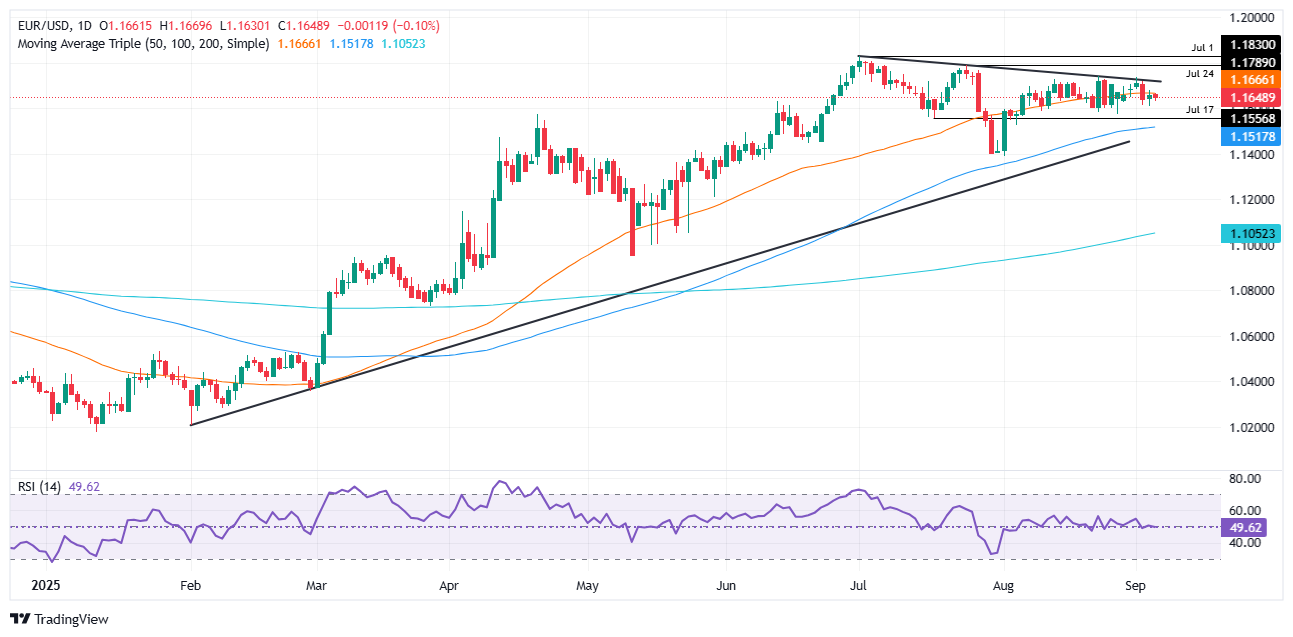Created
: 2025.09.05














![]() 2025.09.05 06:44
2025.09.05 06:44
The EUR/USD retreats after reaching a weekly high of 1.1736 on September 1, as economic data from the US drives the Dollar higher against the shared currency, which witnessed a soft Retail Sales report. The pair trades at 1.1640, down 0.12%.
A tranche of US economic data showed that the labor market is deteriorating. The August Challenger Job cuts showed that companies slashed close to 86K Americans from the labor force, while the ADP National Employment Change report in August, fell short of estimates. The number of people filling up for unemployment benefits rose, amid an environment in which jobs data has taken the center stage.
Market participants are near to fully price in a 25-basis points rate cut by the Fed. Nevertheless, the Nonfarm Payrolls report looming, suggests that EUR/USD traders should wait for the release, before opening fresh positions.
Other data showed that the Trade Balance witnessed an increase in the deficit in July as companies rushed to increase supplies and inventory ahead of tariffs becoming effective. At the same time, business activity in the services sector improved, according to the Institute for Supply Management (ISM).
Given the fundamental backdrop in the US, the scenario suggests that the economy is slowing down, but it remains solid. Nevertheless, the labor market seems to be taking its toll, justifying Fed Chair Jerome Powell pivot in Jackson Hole, where he opened the door to adjust interest rates.
Across the pond, softer than expected Retail Sales report, exerted pressure on the Euro. Despite this, further EUR/USD upside is seen, after Isabel Schnabel, member of the European Central Bank (ECB) was hawkish, calling for steady rates as the economy remains steady.
Traders' eyes shift to Nonfarm Payroll figures on Friday, with economists expecting the economy to add 75K jobs in August.
The table below shows the percentage change of Euro (EUR) against listed major currencies this week. Euro was the strongest against the Japanese Yen.
| USD | EUR | GBP | JPY | CAD | AUD | NZD | CHF | |
|---|---|---|---|---|---|---|---|---|
| USD | 0.41% | 0.47% | 0.96% | 0.62% | 0.47% | 0.79% | 0.73% | |
| EUR | -0.41% | 0.06% | 0.50% | 0.20% | 0.05% | 0.36% | 0.33% | |
| GBP | -0.47% | -0.06% | 0.32% | 0.14% | -0.01% | 0.31% | 0.32% | |
| JPY | -0.96% | -0.50% | -0.32% | -0.29% | -0.49% | -0.15% | -0.19% | |
| CAD | -0.62% | -0.20% | -0.14% | 0.29% | -0.14% | 0.14% | 0.18% | |
| AUD | -0.47% | -0.05% | 0.00% | 0.49% | 0.14% | 0.32% | 0.32% | |
| NZD | -0.79% | -0.36% | -0.31% | 0.15% | -0.14% | -0.32% | 0.01% | |
| CHF | -0.73% | -0.33% | -0.32% | 0.19% | -0.18% | -0.32% | -0.01% |
The heat map shows percentage changes of major currencies against each other. The base currency is picked from the left column, while the quote currency is picked from the top row. For example, if you pick the Euro from the left column and move along the horizontal line to the US Dollar, the percentage change displayed in the box will represent EUR (base)/USD (quote).
EUR/USD consolidated at around 1.1650, with traders unable to reach 1.1700. While the Relative Strength Index (RSI) signals a bullish bias, it has yet to surpass its recent peak, underscoring the pair's consolidation over the past two weeks.
A break above 1.1700 paves the way toward the September 1 high at 1.1736. Once surpassed, the next stop would be 1.1800 and the year-to-date peak at 1.1829. Conversely, a daily close below 1.1650 would expose the 1.1600 handle, with further downside risk toward the 100-day SMA at 1.1520.

The Euro is the currency for the 19 European Union countries that belong to the Eurozone. It is the second most heavily traded currency in the world behind the US Dollar. In 2022, it accounted for 31% of all foreign exchange transactions, with an average daily turnover of over $2.2 trillion a day. EUR/USD is the most heavily traded currency pair in the world, accounting for an estimated 30% off all transactions, followed by EUR/JPY (4%), EUR/GBP (3%) and EUR/AUD (2%).
The European Central Bank (ECB) in Frankfurt, Germany, is the reserve bank for the Eurozone. The ECB sets interest rates and manages monetary policy. The ECB's primary mandate is to maintain price stability, which means either controlling inflation or stimulating growth. Its primary tool is the raising or lowering of interest rates. Relatively high interest rates - or the expectation of higher rates - will usually benefit the Euro and vice versa. The ECB Governing Council makes monetary policy decisions at meetings held eight times a year. Decisions are made by heads of the Eurozone national banks and six permanent members, including the President of the ECB, Christine Lagarde.
Eurozone inflation data, measured by the Harmonized Index of Consumer Prices (HICP), is an important econometric for the Euro. If inflation rises more than expected, especially if above the ECB's 2% target, it obliges the ECB to raise interest rates to bring it back under control. Relatively high interest rates compared to its counterparts will usually benefit the Euro, as it makes the region more attractive as a place for global investors to park their money.
Data releases gauge the health of the economy and can impact on the Euro. Indicators such as GDP, Manufacturing and Services PMIs, employment, and consumer sentiment surveys can all influence the direction of the single currency. A strong economy is good for the Euro. Not only does it attract more foreign investment but it may encourage the ECB to put up interest rates, which will directly strengthen the Euro. Otherwise, if economic data is weak, the Euro is likely to fall. Economic data for the four largest economies in the euro area (Germany, France, Italy and Spain) are especially significant, as they account for 75% of the Eurozone's economy.
Another significant data release for the Euro is the Trade Balance. This indicator measures the difference between what a country earns from its exports and what it spends on imports over a given period. If a country produces highly sought after exports then its currency will gain in value purely from the extra demand created from foreign buyers seeking to purchase these goods. Therefore, a positive net Trade Balance strengthens a currency and vice versa for a negative balance.
![]()
Created
: 2025.09.05
![]()
Last updated
: 2025.09.05

FXStreet is a forex information website, delivering market analysis and news articles 24/7.
It features a number of articles contributed by well-known analysts, in addition to the ones by its editorial team.
Founded in 2000 by Francesc Riverola, a Spanish economist, it has grown to become a world-renowned information website.
We hope you find this article useful. Any comments or suggestions will be greatly appreciated.
We are also looking for writers with extensive experience in forex and crypto to join us.
please contact us at [email protected].
Disclaimer:
All information and content provided on this website is provided for informational purposes only and is not intended to solicit any investment. Although all efforts are made in order to ensure that the information is correct, no guarantee is provided for the accuracy of any content on this website. Any decision made shall be the responsibility of the investor and Myforex does not take any responsibility whatsoever regarding the use of any information provided herein.
The content provided on this website belongs to Myforex and, where stated, the relevant licensors. All rights are reserved by Myforex and the relevant licensors, and no content of this website, whether in full or in part, shall be copied or displayed elsewhere without the explicit written permission of the relevant copyright holder. If you wish to use any part of the content provided on this website, please ensure that you contact Myforex.
Myforex uses cookies to improve the convenience and functionality of this website. This website may include cookies not only by us but also by third parties (advertisers, log analysts, etc.) for the purpose of tracking the activities of users. Cookie policy